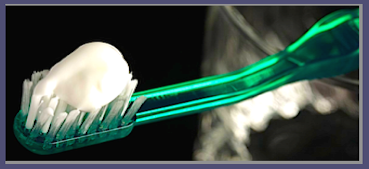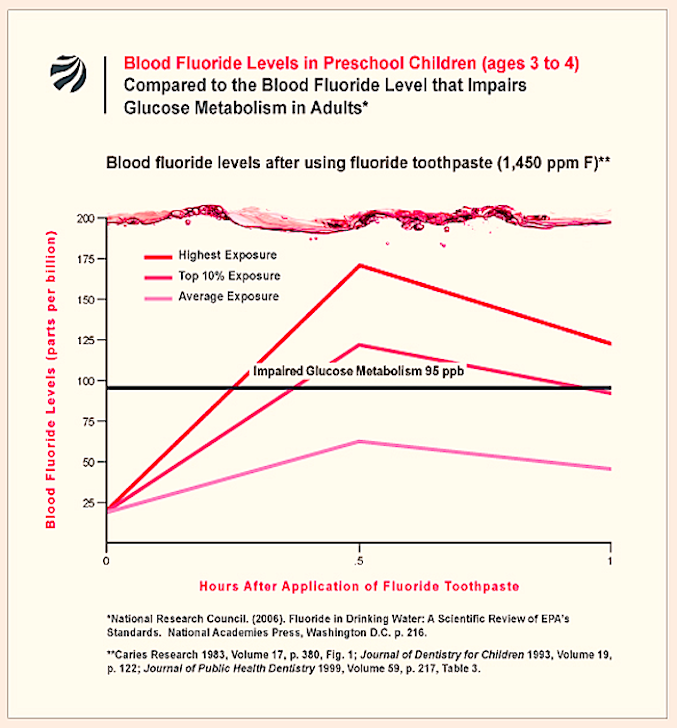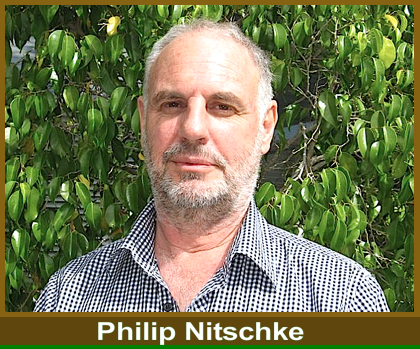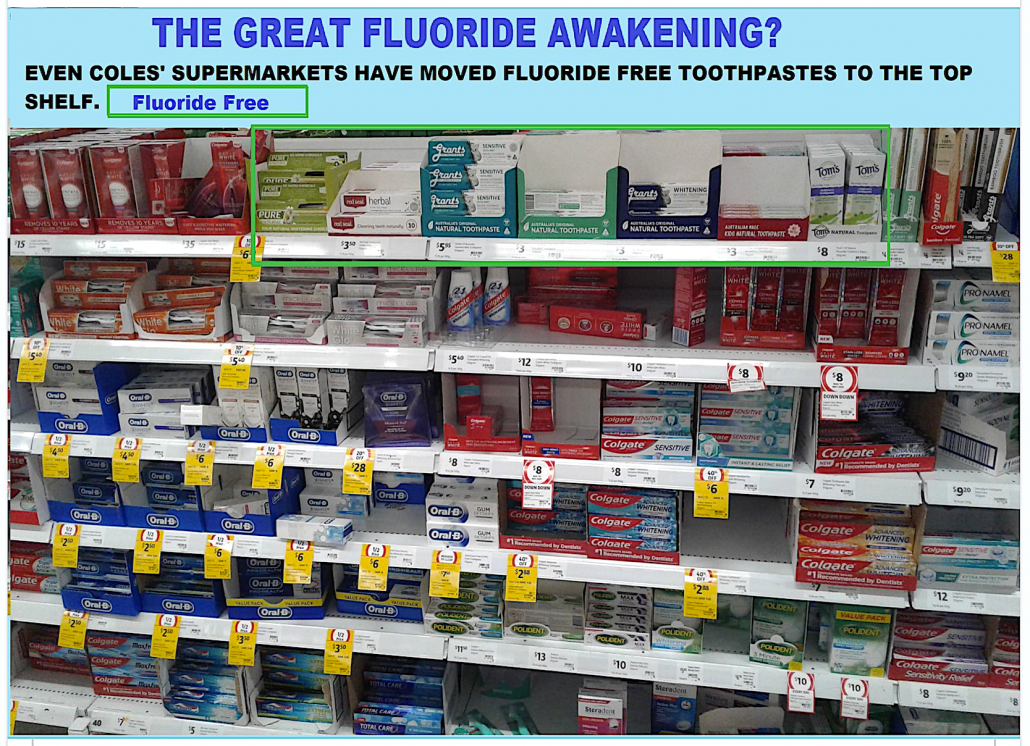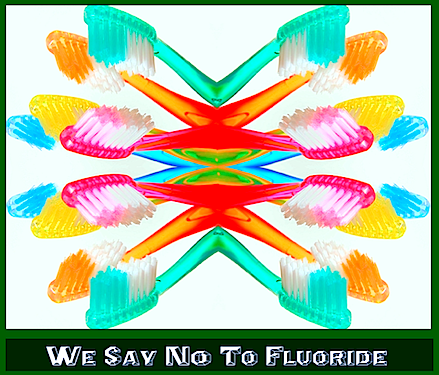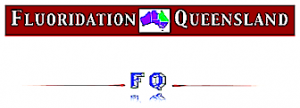FLUORIDE TOOTHPASTE – Keep out of reach…
❝ Two Hundred and Forty Children Under 6 Years Old
died last year from ingesting fluoride toothpaste. ❞ [USA]
~ Keep out of reach of rats, pets and humans ~
→ fluoride toothpastes USA ←
THE AUSTRALIAN GOVERNMENT REMOVED THE ‘ S5 POISON LABELS ‘
ON FLUORIDATED TOOTHPASTE [To help the commercial sales of toothpaste].
THE N.H.M.R.C. RE-CLASSIFIED FLUORIDE TOOTHPASTE
AS A “COSMETIC” [It may have been more accurate to have re-registered it as S6.]
Do Not Use It For Pet Dogs – Thy will swallow it…
Fluoride toothpaste WAS registered as a S5 poison
The N.H.M.R.C. in their book “The Effectiveness of Water Fluoridation” p.131.,
explained the need to examine poison regulations concerning fluoride toothpaste
which was registered as an ‘S5 POISON’ as printed on the package.
The Answer by N.H.M.R.C.
Fluoride Toothpaste an S poison was reclassified as a
“Cosmetic for sales regulations ! ! ! “
An Unusual Method of Suicide:
Fluoride Toxicity Due to Toothpaste Ingestion
Allison Gaines Leanne Cronin, MD Marianne Hamel, MD, PhD
↓ Times are Changing ↓
False advertising from the past
Effect of Sodium Fluoride and Stannous Fluoride
on the Rate of Corrosion of Dental Amalgams
G.E.Stoner, S.E. Senti, & E. Gilead
Department of Materials Science,
School of Engineering and Applied Science,
University of Virginia, Charlottesville, Virginia, USA
GUM DAMAGE
Fluoride actually causes gum damage at the concentrations used in fluoridated toothpaste at 1,000 ppm. Fluoride poisons enzyme activity and slows down the ability of the gums to repair themselves.
If you brush your teeth with fluoridated toothpaste, you will suffer gum damage.
In 2009, there were 24,547 calls to U.S. Poison Control Centers due to ingestion of fluoride toothpaste.
A SAMPLE OF TOXIC INGREDIENTS FOUND IN TOOTHPASTE:
1) Sodium lauryl sulfate – A chemical sudsing agent with well known toxic side effects.
2) Sodium fluoride – Toxic by-product of aluminum and fertilizer chemical plants.
3) Triclosan ♠ – An actual pesticide chemical, used in toothpaste to prevent spoilage.
4) Propylene glycol – An antifreeze chemical used in vehicle radiators.
5) DEA – A foaming agent that’s linked to liver and kidney cancers.
6) Chemical sweeteners – aspartame and saccharin.
♠ Triclosan remains in Children’s Toothpaste Despite Risk…
A recent study demonstrated how quickly blood levels of triclosan may rise in small children exposed to the chemical in toothpaste and hand soap.5 This is one of the first studies to show how triclosan invades the bodies of young children through environmental exposure. Senior study author Joe Braun, assistant professor of epidemiology at Brown University, explained the impetus behind the study:6
“There’s very little data on the exposure in those first years of life. There are a lot of behavioral changes in those years, and environmental chemicals can play a role.”
Braun and his colleagues tested 389 women and children from Cincinnati between pregnancy and until the children were 8 years old. They collected urine three times during the pregnancy and periodically between the children’s first and eighth year. They found triclosan in more than 70 percent of the samples.
Interestingly, by age 8 they found children who used the most hand soap had 66 percent more triclosan in their body, and those who washed their hands more than five times a day had four times more chemical than those who reported washing their hands once or less per day.7 Children who brushed their teeth with toothpaste in the past 24 hours had 2.5 times more triclosan than those who had not used toothpaste. Isaac Pessah, Ph.D., researcher at the University of California, who was not involved in the study, commented:
“It’s a thorough, well-done analysis. Given the high concentrations [of triclosan] in personal care products, you’re seeing that the concentrations in the end user are also quite high.”
Triclosan in More Than Toothpaste and Hand Soap ~
Despite the fact that U.S. manufacturers must phase out triclosan after the FDA banned it and several other chemicals from use in hand soap after concerns were made public that it disrupted the body’s hormonal system, triclosan remains in other personal care products…
Triclosan sticks to toothbrushes – New Info-2017
Don’t be fooled by small print on toothpaste packages (Aust.)
The majority of toothpast manufactures list ‘fluoride’ additives
in very small print! – Are the makers no longer proud of their product?
Colgate problems
The finding (see below) raises the obvious question of whether
the widespread use and ingestion of fluoride toothpaste is
contributing to, or exacerbating, the rising prevalence
of diabetes in children. Diabetes is a condition
caused by persistently high glucose levels.
FULL INFORMATION ⇒ HERE
MONOFLUOROPHOSPHATE (MFP) HISTORY – (toothpaste)
© Peter Meiers
A LIST OF PREFERRED INGREDIENTS
In 2009, there were 24,547 calls to U.S. Poison Control Centers due to ingestion of fluoride toothpaste.
DROWNING IN FLUORIDE (toothpaste)
Nearly all toothpastes sold in the US, the UK and Australia contain fluoride – typically 1000-1500 parts per million. Commonly used mouth rinses contain 230-900 ppm. Fluoride is also present in candy-flavoured treatments and dentifrices. Fluoride products for preventing tooth decay may contain as much as 9000 ppm. Researchers at Madras Dental College and elsewhere found that the fluoride in fluoridated toothpaste, even if not swallowed, is quickly absorbed through the lining of the mouth and gums into the general circulation (Lancet, 1991; 337: 1213).
Toothpaste and vitamin preparations – and presumably baby formulas – containing fluoride cause allergic reactions in some children, toxic reactions in others (see www.cadvision.com/-fluoride/adverse).
The resulting mouth ulcers don’t respond to antibiotics or local medications, but clear up promptly when non-fluoride toothpaste is substituted (Ann Allergy; 1967; 25: 388-91)…… Full text → HERE
(It makes good rat bait)
By Dr. Mercola Link to original → HERE ←
Fluoride is a toxic industrial waste product that is a poison to your body even in trace amounts, yet it is added to the majority of US water supplies using the rationale that it helps prevent dental cavities.
The archaic practice continues even though it is now widely recognized that fluoride’s only justifiable benefit comes from topical contact with teeth – and even that is debatable.
To put it simply, there are FAR better options for decreasing tooth decay than ingesting a harmful industrial pollutant or using a topical poison like fluoride… in fact, new research suggests even chocolate extract would make a better alternative.
CHOCOLATE TOOTHPASTE WORKS BETTER THAN FLUORIDE
A recent study presented at the American Dental Association (ADA) 2013 Annual Session pitted fluoride toothpaste against a new toothpaste that contains the naturally-occurring cacao extract theobromine.
This test determined which product better repaired and re-mineralized exposed dentin (the tissue that makes up the bulk of your teeth below the enamel). Exposed dentin is a leading cause of tooth hypersensitivity.
The results showed that patients who brushed their teeth with the cacao-extract toothpaste twice a day for one week had “100 percent dental occlusion” with their tooth dentin becoming re-mineralized or repaired. According to a press release:1
“The comparison to toothpastes containing fluoride – one as much as 5,000 ppm [parts per million] – validates what our research has shown all along: that Rennou [the cocoa extract] … is more effective and safer than fluoride, which can be toxic if ingested.”
Past research has also shown that the chocolate ingredient theobromine works better than fluoride. When lesions in artificial enamel were treated with theobromine, remineralization occurred at a greater rate than when they were treated with fluoride.2 The study found, in fact, that theobromine made teeth less vulnerable to bacterial acid erosion that could lead to cavities.
SCIENTISTS NOW QUESTIONING WHETHER FLUORIDE
WORKS TO FIGHT CAVITIES
With potential alternatives like theobromine, which, unlike fluoride, are not harmful when swallowed, it’s unfortunate that fluoride can still be found in a vast assortment of toothpastes, mouthwashes and professionally applied fluoride treatments. It’s even added to your drinking water for this purpose, as mentioned.
Yet fluoride, long heralded as the answer to decaying teeth, is receiving increasing scrutiny –
and for good reason.
A groundbreaking study published in the journal Langmuir4 uncovered that the fluorapatite layer formed on your teeth from fluoride is a mere six nanometers thick. To understand just how thin this is, you’d need 10,000 of these layers to get the width of a strand of your hair!
Scientists now question whether this ultra-thin layer can actually protect your enamel and provide any discernible benefit, considering the fact that it is quickly eliminated by simple chewing. They wrote:
“ …it has to be asked whether such narrow… layers really can act as protective layers for the enamel.”
FLUORIDE TOOTHPASTE CAN BE DEADLY TO CHILDREN
I’m not a fan of fluoridated toothpaste for adults or children, but if you do decide to use it, it’s probably best to keep it safely out of the reach of your children. Fluoride toothpaste is often the largest single source of fluoride intake for young children, and is a major risk factor for disfiguring dental fluorosis.
This is because children swallow a large amount of the paste that they put in their mouth. In fact, research has shown that it is not uncommon for young children to swallow more fluoride from toothpaste alone than is recommended as an entire day’s ingestion from all sources.5
If you have a young child, it’s recommended that you use a non-fluoride toothpaste. If, however, you do use fluoride toothpaste, it’s very important that you supervise your children while they brush to make sure they use no more than a “pea-sized amount” of paste, and that they fully rinse and spit after they finish.
And, lastly, do not purchase candy-flavored toothpaste (e.g., bubble-gum and watermelon) as these toothpastes (which still contain adult-strength concentrations of fluoride) increase the risk that your children will swallow it (and actually want to swallow it). Still, it’s hard to ignore the absurdity that poison control should be called if you swallow a quarter milligram of fluoride from toothpaste while just ONE glass of water can contain this amount of fluoride.
THE INSANITY OF SWALLOWING FLUORIDE TO PREVENT CAVITIES
Apply toxic fluoride topically to your teeth is bad enough from a health (and lack of effectiveness) perspective, but swallowing it daily in your drinking water takes this fluoride insanity to a whole other level.
The science clearly demonstrates that fluoride is a toxic chemical that accumulates in your tissues over time, wreaks havoc with enzymes, and produces a number of serious adverse health effects, including neurological and endocrine dysfunction.
Children are particularly at risk for adverse effects of overexposure. Scientists from the US Environmental Protection Agency’s (EPA) National Health and Environmental Effects Research Laboratory have classified fluoride as a “chemical having substantial evidence of developmental neurotoxicity,” 25 studies have now reported an association between fluoride exposure and reduced IQ in children.
Greyhound Care Manual
* Important Note: Never use human tooth paste for your dog!
Fluoride found in human tooth paste is poisonous and your dog
can not spit it out of his mouth and will get very ill ingesting it.
THE SAFEST SOLUTION TO BETTER DENTAL HEALTH
Toothpaste containing natural ingredients, like theobromine and others, appears to be more effective and safer than fluoride-containing toothpastes. Water fluoridation, too, is ineffective and may offer no benefit at all for your teeth, not to mention placing your overall health in jeopardy. There’s no reason to risk it. Here are my basic guidelines for optimizing your dental health, safely and naturally:
-
Avoid fluoridated water and fluoridated toothpaste.
-
Minimize your sugar and grain consumption. Keep your fructose intake to less than 25 grams per day. Avoid processed foods.
-
Make sure you consume a diet rich in fresh, whole foods, fermented vegetables, and grass-fed meats, which will ensure you’re getting plenty of the minerals that are so important for strong bones and teeth.
-
Practice good oral hygiene and get regular cleanings from a mercury-free natural dentist.
-
Consider oil pulling with coconut oil, which is a powerful inhibitor of a large variety of pathogenic organisms.
JOIN THE FIGHT TO GET FLUORIDE OUT OF DRINKING WATER
There’s no doubt about it: Fluoride should not be ingested. At least when it comes to topical application, you have a choice. You can easily buy fluoride-free toothpaste and mouthwash. But you’re stuck with whatever your community puts in your water, and it’s very difficult to filter out of your water once it’s added. Many do not have the resources or the knowledge to do so.
The only real solution is to stop the archaic practice of water fluoridation in the first place. Fortunately, the Fluoride Action Network has a game plan to END water fluoridation, both in the United States and Canada. Clean, pure water is a prerequisite to optimal health. Industrial chemicals, drugs and other toxic additives really have no place in our water supplies. So, please, support the anti-fluoride movement by making a donation to the Fluoride Action Network today.
❝ Two Hundred and Forty children under 6 years old
died last year from ingesting fluoride toothpaste. ❞ [USA]
Read the label on fluoride toothpaste:
Toothpaste contains 1000 to 1,450 parts
per million (ppm) of fluoride.
Brushing with Fluoride Can Give You a Radiant Smile:
COLGATE ‘NEUTRAFLUOR’ TOOTHPASTE 5000 (56g)
❝ This product is a Pharmacist Only Medicine and requires pharmacist advice for us to send it to you. If you order this product, you will be required to call us within 48 hours on 1300 367 283 to complete the order. In the event that you do not do this, the product will be deleted from your order and the balance of your order will be dispatched.
This is not required if you have a doctor’s prescription.
DIRECTIONS:
Adults and children 6 years or older, apply a thin ribbon of Neutrafluor 5000 Plus to a soft, small headed, multi-tufted toothbrush.
Brush thoroughly for two minutes preferably at bedtime, or use as recommended be your dental professional.
Adults should spit out after brushing.
Children aged 6-16 years, should brush under supervision, spit out after use and rinse mouth thoroughly.
For best results, avoid eating or drinking for 30 minutes.
INGREDIENTS:
Contains 1.1% w/w Neutral Sodium Fluoride.
Also contains: Sodium benzoate; Sodium saccharin.
Warnings:
DO NOT SWALLOW:
As with all medications, keep out of reach of infants and children. Neutral Sodium Fluoride Rinse Side Effects
Please note – some side effects for Neutral Sodium Fluoride Rinse may not be reported.
Always consult your doctor or healthcare specialist for medical advice.
You may also report side effects to the FDA at http://www.fda.gov/medwatch/ or 1-800-FDA-1088 (1-800-332-1088).
READ MORE:
http://www.drugs.com/sfx/neutral-sodium-fluoride-rinse-side-effects.html#ixzz10cgldgBE
NeutraFluor 5000 Plus is a high concentration sodium fluoride toothpaste for use by patients who have a high risk of dental decay (caries). Scientific research concludes that when toothpaste containing a relatively high amount of fluoride is applied to the teeth it offers increased protection against acid attack from decay causing bacteria in the mouth.
WHAT IS IN THE PRODUCT?
This toothpaste contains fluoride, and each treatment dose, i.e. a thin ribbon of paste on a tooth brush contains 2.5mg fluoride
(5,000ppm sodium fluoride). The toothpaste also contains a number of other ingredients. These are necessary to facilitate the consistency, flavour, foaming and cleaning actions of the toothpaste. These ingredients include silica, sorbitol, saccharin, polyethylene glycol, gum, flavour, sodium benzoate, sodium laurel sulphate, titanium dioxide, sodium hydroxide and brilliant blue colour.
NeutraFluor 5000 Plus is registered on the Australian Register of
Therapeutic Goods and its number is Aust R 67437.
NeutraFluor 5000 Plus comes in a 56g tube.
BEFORE USING THIS PRODUCT
NeutraFluor 5000 Plus should only be used on the recommendation of your dentist or doctor, as part of a tooth decay prevention routine.
NeutraFluor 5000 Plus should not be used by any person with known allergic reactions to fluoride or the other ingredients stated above.
Children under 6 years should not use NeutraFluor 5000 Plus unless recommended by a dentist or doctor.
Pregnant or breastfeeding women should be cautious before using this product and discuss its use with their dentist or doctor.
DO NOT SWALLOW THE TOOTHPASTE
The toothpaste acts on the surface of your teeth and does not need to be swallowed.
Dosage: Follow these instructions unless otherwise instructed by your dentist or doctor:
1. Adults and children 6 years and older:
Apply a thin ribbon of NeutraFluor 5000 Plus to a soft, small headed, multi-tufted toothbrush. Brush teeth thoroughly for two minutes.
2. After use: Adult spit out. Children aged 6 -16 years spit out after use and rinse mouth thoroughly. For best results, do not eat, drink or rinse your mouth for 30 minutes.
3. NeutraFluor 5000 Plus is easily applied on a toothbrush and should be used daily in place of regular fluoride toothpaste unless otherwise instructed by your dentist or doctor.
4. In the event of an overdose, contact your nearest Poisons Information Centre (or hospital accident and emergency department), or tell your doctor immediately.
UNWANTED EFFECTS:
Allergic reactions have been rarely reported with the use of fluoride toothpastes. Should you experience any unwanted effect from using the product you should stop using the product and consult your doctor or dentist.
HOW TO STORE THE PRODUCT:
You should keep your NeutraFluor 5000 Plus below 25°C and out of reach of children.
This product should not be used after the expiry date which is clearly marked at the crimp on the end of the tube.
NeutraFluor 5000 Plus is a product developed by Colgate-Palmolive.
Colgate Oral Care 345 George Street Sydney NSW 2000
For all enquiries regarding this product, please call Consumer
Information Service (Free Call) 1800802 307 (Australia) or
0800 441 740 (New Zealand)
This package leaflet was developed in January 1999.
Published by MIMS/myDr November 2000 ❞
EXTRACT FROM ANOTHER WEB SITE:
❝ Conclusions: This review suggests that the training of staff in the form of a comprehensive practically oriented program addressing areas such as oral diseases, oral screening assessment, and hands-on demonstration of oral hygiene techniques and products is likely to have a positive impact on the management of oral hygiene care within residential aged care facilities. The review also identified that regular brushing with fluoride toothpaste, use of therapeutic fluoride products and application of therapeutic chlorhexidine gluconate products are validated by research as effective for the general population and some populations with special needs. ❞
❝ This toothpaste has a very high fluoride content for at risk patients ie elderly patients with dry mouths at risk of root caries, patients with teeth that are sensitive due to exposed dentine and institutionalised or otherwise people unable to look after their teeth. It should not be swallowed and is unsuitable for use by children under the age of 10. …❞
THIS TOOTHPASTE CONTAINS A NUMBER OF OTHER INGREDIENTS:
“These are necessary to facilitate the consistency, flavour, foaming and cleaning
actions of the toothpaste.
These ingredients include: silica, sorbitol, saccharin, polyethylene glycol, gum,
flavour, sodium benzoate, sodium laurel sulphate, titanium dioxide,
sodium hydroxide` and brilliant blue colour.”
Exit International (Assisted Suicide/ Voluntary Euthanasia)
Exit International is a leading End of Life Choices law reform
& information/ advocacy non-profit, founded by :
Dr Philip Nitschke PhD, MD
This product is legal, lethal, and cheaper than
an airline ticket to Mexico for phenobarbitone,
or a one way ticket to Zurich for ‘Death Tourism’.
One Tube of Toothpaste – Cheap 3 Months Rat & Mouse Free
Healing Teeth Naturally – what to avoid
P.S. It IS posible to buy safe toothpaste, fluoride-free.
( YES – made in Australia – available at most stores ! )
OK to eat – “Not too bad on fresh wholemeal bread and real dairy butter”
YES – Grants – made in Australia !
There are several brands of toothpaste that do NOT contain fluoride.
See also: ‘MODERE’ (formerly ‘Neways’) – www.modere.com.au
[Chinese Fluoride Free Toothpaste]
![]()




